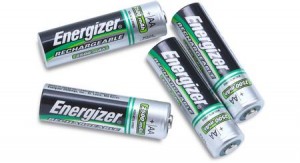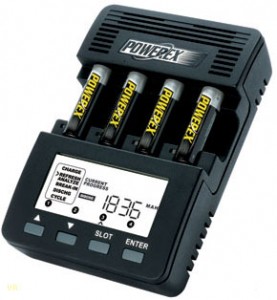I receive a lot of emails from readers and listeners who are new to shortwave radio. The bulk of the emails I receive ask for advice about which radio to pick for travel, for home, or for work. A lot of emails, however, are from listeners who wish to improve the performance of their portable radios.
One of the first things I suggest–especially if they’re hearing a lot of interference noise on the radio–is simply to unplug the AC adapter (a.k.a., “wall wart”) and run the portable off batteries. Why? Quite often, those wall warts are injecting a lot of noise into your receiver. Find it hard to believe? Give it a try!

Not all rechargeable batteries are created equal. Choose name-brand, higher quality cells. Dollar store batteries lack longevity and capacity.
Solution: Rechargeable batteries
I get so annoyed with noisy wall warts, that I simply never use them. Instead, some time ago I started investing in rechargeable batteries. Though one pays a bit more for them (than for alkaline batteries) initially, they can be recharged hundreds of times, and thus last for years.
You can buy rechargeable batteries nearly anywhere these days, and the price has dropped significantly over the past few years, even for name-brand batteries.
It’s worth noting that I’ve bought rechargeable batteries at radio hamfests or dollar stores that were as cheap as $1US per AA cell. Big mistake–not only do these ultra-cheap batteries not hold a charge for long, but they also wear out more quickly. Instead, stick with name brand rechargeables, like Energizer, Duracell, RadioShack, or (my personal favorite) Powerex.
About 85% of the shortwave portables I own are powered by AA cells, the remaining 20% off of AAA’s (you’ll find that I gripe about the ones that use AAA’s, by the way). When I buy a new portable–one that I plan to keep after reviewing on SWLing.com–I invest in twice the number of rechargeable batteries that the portable holds. For example, my Sony ICF-SW7600GR operates on 4 AA cells, thus I bought a pack of 8 cells for its operation. That way, I can always have an extra set of charged batteries available when I deplete those in the unit.
There are three main types of rechargeables available: NiCd (nickel cadmium), Lithium Ion, and NiMH (nickel-metal hydride). Without going into too much detail, I recommend NiMH batteries–they offer the best bang for the buck, are widely available, and with correct care, do not easily develop a memory effect.
A few tips for making NiMH rechargeables last longer
NiMH batteries are fairly fool-proof, but there are some simple rules of thumb you should follow to insure that they provide years of service:
- Never mix old and new rechargeables
- Never mix LiIon and NiMH cells
- Nickel-based cells, such as our NiMH’s need to be fully discharged occasionally, else the batteries lose capacity over time in a phenomenon known as the “memory effect.” Once my radio has depleted its current set of batteries, I’ll often pop them into a flashlight to deplete them even further before recharging.
- Label your batteries with a piece of colored tape or a marker to note the purchase date on the cell–that way, you’ll easily keep like batteries together and charged in sync.

The Maha MHC9000 is pricey, and you will need the manual to operate it, but it's a very high-quality battery charger and conditioner. I have brought nearly dead NiMH batteries back to life with this wonderful machine.
Like batteries, not all chargers are created equal. You should opt for a higher-quality, NIMH-specific charger. Ideally, since most radios require 3-4 batteries at a time, purchase a charger that will hold at least 4 batteries.
You can see that I’m very fond of the Maha brand battery chargers, though there are other good chargers on the market. Maha receives high praise from many amateur radio operators, and I’ve had excellent luck with them, too. What I especially like about the Maha/Powerex company is that they focus all of their innovation in the area of batteries and charging systems for a wide variety of uses.
Throw away the wall warts!
Have I convinced you yet? Don’t even bother unpacking the AC adapter that comes with your radio! You don’t really need it. “But wait,” you may be thinking, “my radio has a built-in battery charger, so don’t I need my AC adapter?” Even if your radio has a built-in battery charging function, it’s probably very basic and should only be used if you have no other option. Many of these are prone to over- or under-charge batteries, and take hours to complete this relatively simple task.
Trust me: your portable shortwave reciever will perform at its best when powered by quiet, rechargeable NiMH batteries charged properly with a good-quality charger. Try it, and hear for yourself.

Though the NI-MH rechargeable AA’s are only 1.2 volts and alkaline AA’s are 1.5 volts do you find that your reception range and signal strength or voice clarity is lessened by the voltage difference ? I travel with a Grundig G-3 and a Sony ICF 7600 GR, and rent a cabin, so I can put up a 50′ dipole in the trees in front of it.Thanks,much.
For home use, the batteries only last about 9 hours, making recharging a constant chore I’d rather avoid. I find the best thing for the ac adapter is a snap on ferrite core. It doesn’t get rid of all of the powerline noise, but most of it. Most of the common ones have enough attenuation down to a few mhz if the wire is wrapped around the ferrite a few times, counts as three turns. Most of the cheap switching mode adapters on Ebay and elsewhere produce a ton of rfi no ferrite will block enough of it, avoid them at all costs and stick with transformer based ones.
I have used NIMH, however I currently use Enloop ready to use rechargeables, along with the Maha-C808M which charges D,C,AA & AAA. I too keep a portable Maha charger just for traveling (MH-C401FS) which can be used from the wall, or accessory outlets in most vehicles. The whole solar thing however is a problem as most chargers just don’t have practical charging characteristics. If needed, just plug a solar panel/controller into your vehicle outlet to keep the battery or batteries charged up, then charge your portable batteries at will. For those situations when you need total portable operation with no wall or vehicle outlets available I would recommend something like the Anker Mobile Power battery (Model 79AN20L) a Li-polymer battery (20000mAh/74Wh). It comes with a wall & vehicle plugin, and can be charged with a suitable solar panel/controller allowing stand alone portable power with outputs of DC 12/16/19 volts, and a 5 volt USB outlet it will provide virtually any portable power need.
As to the new 3.7 volt cells now obviously beginning to be used, as well as the now common 3.0 volt (CR123A) batteries, found in many flashlights today… Rechargeables like those found in the new Tecsun, and rechargeables (such as the 3.0 V Tenergy RCR123A) along with respective chargers will fit right in. Yes the Tecsuns with USB plugs can be run/charged from all battery options (vehicle/Ankers) giving complete flexibility and low/no noise like wall-warts do.
Besides, it causes many appreciative looks in places like Starbucks when you sit down with your chosen beverage… In the padded seats far from the crowds surrounding the available (over-used wall outlets) and just plug into your small bag (The slim Ankers fits almost invisibly inside a small go-bag) . The looks on their faces is priceless. Not to mention the friends you make by offering a spare USB port for empty smartphones. 😉
What a cool setup, Tim. I bet you do get some looks at Starbuck! Take it to an airport–where there’s one outlet per 300 people–and you’d make even more friends. Thanks for sharing!
There’s another good reason to run your portable using batteries. If you’re using a computer to decode digital signals, or to record what you’re hearing, there is far less noise on the audio input (from radio to computer) when the radio is not connected to the AC mains. I don’t know if this is because noise on the AC is making it into the radio’s audio output socket, or if there’s some sort of ground loop effect happening (because the connection between radio and computer means the entire system now has two separate paths to ground) but switching the radio to batteries makes the audio much better.
Greg S
radiologbook.blogspot.com
Simple but great advice!
Bill (RADIO-TIMETRAVELLER)
http://radio-timetraveller.blogspot.com